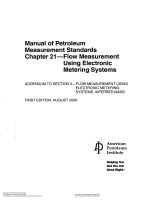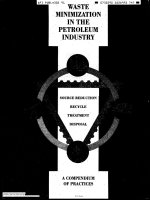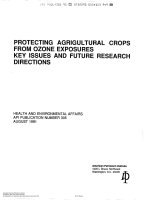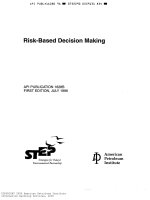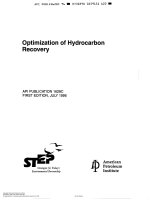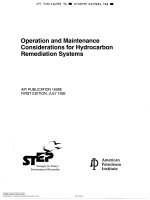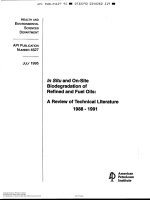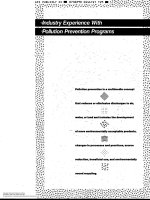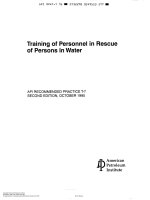Api mpms 4 3 1988 (2002) scan (american petroleum institute)
Bạn đang xem bản rút gọn của tài liệu. Xem và tải ngay bản đầy đủ của tài liệu tại đây (1.63 MB, 29 trang )
Manual of Petroleum
Measurement Standards
Chapter 4- Proving Systems
Section 3-Small
Volume Provers
FIRST EDITION, JULY 1988
REAFFIRMED, OCTOBER 1993
,
Reaffirmed 3/2002
1
American Petroleum Institute
1220 L Street, Northwest
Washington, D.C. 20005
11’
Manual of Petroleum
Measurement Standards
Chapter 4-Proving Systems
Section 3-Small
Volume Provers
Measurement Coordination Department
FIRST EDITION, JULY 1988
American
Petroleum
Institute
SPECIAL NOTES
1. API PUBLICATIONS NECESSARILY ADDRESS PROBLEMS OF A
GENERAL NATURE. WITH RESPECT TO PARTICULAR CIRCUMSTANCES, LOCAL, STATE, AND FEDERAL LAWS AND REGULATIONS
SHOULD BE REVIEWED.
2. API IS NOT UNDERTAKING TO MEET THE DUTIES OF EMPLOYERS,
MANUFACTURERS, OR SUPPLIERS TO WARN AND PROPERLY TRAIN
AND EQUIP THEIR EMPLOYEES, AND CTTHERS EXPOSED, CONCERNING HEALTH AND SAFETY RISKS AND PRECAUTIONS, NOR
UNDERTAKING THEIR OBLIGATIONS UNDER LOCAL, STATE, OR
FEDERAL LAWS.
3. INFORMATION CONCERNING SAFETY AND HEALTH RISKS AND
PROPER PRECAUTIONS WITH RESPECT TO PARTICULAR MATERIALS
AND CONDITIONS SHOULD BE OBTAINED FROM THE EMPLOYER, THE
MANUFACTURER OR SUPPLIER OF THAT MATERIAL, OR THE
MATERIAL SAFETY DATA SHEET.
4. NOTHING CONTAINED IN ANY API PUBLICATION IS TO BE
CONSTRUED AS GRANTING ANY RIGHT, BY IMPLICATION OR
OTHERWISE, FOR THE MANUFACTURE, SALE, OR USE OF ANY
METHOD, APPARATUS, OR PRODUCTCOVERED BY LETTERS PATENT.
NEITHER SHOULD ANYTHING CONTAINED IN THE PUBLICATION BE
CONSTRUED AS INSURING ANYONE AGAINST LIABILITY FOR
INFRINGEMENT OF LETTERS PATENT.
-
5. GENERALLY, API STANDARDS ARE REVIEWED AND REVISED,
REAFFIRMED, OR WITHDRAWN AT LEAST EVERY FIVE YEARS.
SOMETIMES A ONE-TIME EXTENSION OF UP TO TWO YEARS WILL BE
ADDED TO THIS REVIEW CYCLE. THIS PUBLICATION WILL NO
LONGER BE IN EFFECT FIVE YEARS AFTER ITS PUBLICATION DATE AS
AN OPERATIVE API STANDARD OR, WHERE AN EXTENSION HAS BEEN
GRANTED, UPON REPUBLICATION. STATUS OF THE PUBLICATION
CAN BE ASCERTAINED FROM THE API AUTHORING DEPARTMENT
\TELEPHONE (202) 682-8000]. A CATALOG OF API PUBLICATIONS AND
MATERIALS IS PUBLISHED ANNUALLY AND UPDATED QUARTERLY
BY API, 1220 L STREET, N.W., WASHINGTON, D.C. 20005.
Copyright O 1988 American Petroleum Institute
FOREWORD
Chapter 4 of the Manual of Petroleum Measurement Standards was prepared as
a guide for the design, installation, calibration, and operation of meter proving
systems commonly used by the majority of petroleum operators. The devices and
practices covered in this chapter may not be applicable to all liquid hydrocarbons
under all operating conditions. Other types of proving devices that are not covered
in this chapter may be appropriate for use if agreed upon by the parties involved.
The information contained in this edition of Chapter 4 supersedes the information contained in the previous edition (First Edition, May 1978), which is no longer
in print. It also supersedes the information on proving systems contained in API
Standard 1101, Measurement of Petroleum Liquid Hydrocarbons by Positive Displacement Meter (First Edition, 1960); API Standard 2531, Mechanical Displacement Meter Provers; API Standard 2533, Metering Viscous Hydrocarbons; and API
Standard 2534, Measurement of Liquid Hydrocarbons by Turbine-Meter Systems,
which are no longer in print.
This publication is primarily intended for use in the United States and is related
to the standards, specifications, and procedures of the National Bureau of Standards (NBS). When the information provided herein is used in other countries, the
specifications and procedures of the appropriate national standards organizations
may apply. Where appropriate, other test codes and procedures for checking pressure and electrical equipment may be used.
For the purposes of business transactions, limits on error or measurement tolerance are usually set by law, regulation, or mutual agreement between contracting
parties. This publication is not intended to set tolerances for such purposes; it is
intended only to describe methods by which acceptable approaches to any desired
accuracy can be achieved.
Chapter 4 now contains the following sections:
Section 1, “Introduction”
Section 2, “Conventional Pipe Provers”
Section 3, “Small Volume Provers”
Section 4, “Tank Provers”
Section 5, “Master-Meter Provers”
Section 6, “Pulse Interpolation’’
Section 7, “Field-Standard Test Measures”
API publications may be used by anyone desiring to do so. Every effort has been
made by the Institute to assure the accuracy and reliability of the data contained in
them; however, the Institute makes no representation, warranty, or guarantee in
connection with this publication and hereby expressly disclaims any liability or
responsibility for loss or damage resulting from its use or for the violation of any
federal, state, or municipal regulation with which this publication may conflict.
Suggested revisions are invited and should be submitted to the director of the
Measurement Coordination Department, American Petroleum Institute, 1220 L
Street, N.W., Washington, D.C. 20005.
iii
SECTION >SMALL
VOLUME PROVERS
Page
4.3.1 Introduction .................................................
4.3.1.1 Scope ..................................................
4.3.1.2 Definition of Terms ......................................
4.3.1.3 Referenced Publications ..................................
4.3.2 Small Volume Prover Systems ..................................
4.3.3 Equipment ..................................................
4.3.3.1 Materials and Fabrication .................................
4.3.3.2 Temperature Stability ....................................
4.3.3.3 Temperature Measurement ...............................
4.3.3.4 Pressure Measurement ...................................
4.3.3.5 Displacing Devices ......................................
4.3.3.6 Valves .................................................
4.3.3.7 Connections ............................................
4.3.3.8 Detectors ...............................................
4.3.3.9 Meter Pulse Generator ...................................
4.3.3.10 Pulse-Interpolation System ..............................
4.3.3.1 1 Controller .............................................
4.3.4 Design of Small Volume Provers ...............................
4.3.4.1 Initiai Considerations ....................................
4.3.4.2 Pressure Drop Across the Prover ..........................
4.3.4.3 Displacer Velocity .......................................
4.3.4.4 Volume ................................................
4.3.4.5 Critical Parts ............................................
4.3.4.6 Counters ...............................................
4.3.4.7 Meter Proving Guidelines ................................
4.3.5 Sample Calculations for the Design of Small Volume Provers ......
4.3.5.1 Problem ................................................
4.3.5.2 Solution ................................................
4.3.5.3 Summary of Prover Design Calculations ....................
4.3.5.4 Other Considerations ....................................
4.3.6 Installation ..................................................
4.3.7 Calibration ..................................................
4.3.7.1 General Considerations ..................................
4.3.7.2 Waterdraw Method ......................................
4.3.7.3 Calibrating Bidirectional Provers ..........................
4.3.7.4 Calibrating Unidirectional Provers .........................
4.3.7.5 Repeatability ...........................................
4.3.7.6 Certificate of Calibration .................................
4.3.8 Operation ...................................................
4.3.9 Nonuniform Pulses ...........................................
APPENDIX A-EVALUATION OF DISPLACEMENT METER
PULSE VARIATIONS ..............................
APPENDIX B-METER FACTOR DETERMINATION WITH
SMALL VOLUME PROVERS .......................
Figures
l-Generalized System Overview .................................
2-System Overview. Internal Valve ..............................
V
1
1
1
1
2
2
2
2
2
2
2
7
7
7
7
7
7
7
7
8
8
8
8
8
8
8
9
.9
11
11
11
12
12
12
12
14
14
14
15
15
17
23
3
4
%System Overview. Internal Bypass Porting With External Valve ...
&System Overview. Pass-Through Displacer With External Valve ...
%System Overview for Waterdraw Calibration ....................
A-1-Pulse Variation Graph/Direct .................................
A-2-Pulse Variation Graph/Geared ................................
A-%Pulse Variation Graph/4-Percent Adjustment ...................
vi
5
6
13
19
20
21
Chapter &Proving
SECTION &SMALL
4.3.1
Systems
VOLUME PROVERS
Introduction
4.3.1.2.1 Interpulse spacing refers to variations in the
meter pulse width or space, normally expressed in percent.
The use of small volume provers has been made
possible by the availability of high-precision displacerposition detectors used in conjunction with pulseinterpolation techniques (see Chapter 4.6). The small
volume prover normally has a smaller base volume than
that of conventional pipe provers (see Chapter 4.2) and
is usually capable of fast proving passes over a wide
range of flow rates.
Small volume provers have a volume between detectors that does not permit a minimum accumulation of
10,OOO direct (unaltered) pulses from the meter. Small
volume provers require meter pulse discrimination using a pulse-interpolation counter or another technique
that increases the resolution (see Chapter 4.6). This
may include using provers with both large and small
base volumes, depending on the pulse rates of the meters to be proved.
The small volume prover may be used in many
applications in which pipe provérs or tank provers are
commonly used. Small volume provers may be stationary or portable.
The volume required of a small volume prover can be
less than that of a conventional pipe prover when highprecision detectors are used in conjunction with pulseinterpolation techniques. Pulse-interpolation methods
of counting a series of pulses to fractional parts of a
pulse are used to achieve high resolution without counting 10,Oûû whole meter pulses for a single pass of the
displacer between detectors (see Chapter 4.6.)
To achieve the required proving accuracy and repeatability, the minimum volume between detector switches
depends on the discrimination of a combination of
pulse-interpolation electronics, detectors, and uniform
meter pulses, as well as flow rate, pressure, temperature, and meter characteristics.
4.3.1.2.2 Meter proof refers to the multiple passes or
round trips of the displacer in a prover for purposes of
determining a meter factor.
4.3.1.2.3 A meter prover is an open or closed vessel of
known volume utilized as a volumetric reference standard for the calibration of meters in liquid petroleum
service. Such provers are designed, fabricated, and
operated within the recommendations of Chapter 4.
4.3.1.2.4 A prover pass is one movement of the displacer between the detectors in a prover.
4.3.1.2.5 A prover round trip is the result of the forward and reverse passes in a bidirectional prover.
4.3.1.2.6 A proving timerlcounter is a high-speed
counter used in double chronometry to measure time
with a pulsed signal of known frequency.
4.3.1.3
REFERENCED PUBLICATIONS
The current editions of the following standards,
codes, and specifications are cited in this chapter:
API
Manual of Petroleum Measurement Standardy
Chapter 4, “Proving Systems,” Section 2, “Conventional Pipe Provers,” Section 6, “Pulse lnterpolation,” and Section 7, “Field-Standard Test
Measures”
Chapter 5, “Metering,” Section 2, “Measurement of Liquid Hydrocarbons by Displacement
Meters,” Section 3, “Measurement of Liquid
Hydrocarbons by Turbine Meters,” and Section
4, “Accessory Equipment for Liquid Meters”
Chapter 7.2, “Dynamic Temperature Determination”
Chapter 12.2, “Calculation of Liquid Petroleum
Quantities Measured by Turbine or Displacement Meters”
4.3.1.1 SCOPE
This chapter outlines the essential elements of a small
volume prover and provides descriptions of and operating details for the various types of small volume provers that meet acceptable standards of repeatability and
accuracy.
NFPA‘
70 National Elecrrical Code
4.3.1.2
DEFINITION OF TERMS
Terms used in this chapter are defined in 4-3-1.2.1
through 4.3.1.2.6.
National Fire Protection Association, Batteryrnarch Park. üuincy.
Massachusetts 02269.
1
1
2
CHAPTER 4-PROVING
__
4.3.2
Small Volume Prover Systems
'I'he small volume prover is available in several differconfigurations that allow a continuous and uniform
rate of flow. All types operate on the common principle
of the repeatable displacement of a known volume of
liquid in the calibrated section of a pipe or tube. A
displacer travels through a calibrated section with its
limits defined by one or more highly repeatable detectors. 'The corresponding metered volume simultaneously passes through the meter, and the whole number of pulses is counted. Precise calculations are made
using a pulse-interpolation technique (see Chapter 4.6).
The two types of continuous-flow small volume provers are unidirectional and bidirectional. The unidirectional prover allows the displacer to travel and
measure in only one direction through the proving section and has a means of returning the displacer to its
starting position. The bidirectional prover allows the
displacer t o travel and measure first in one direction and
then in the other and is capable of reversing the flow
through the prover section.
Both unidirectional and bidirectional small volume
provers must be constructed so that the full flow of the
streani passing through the meter being proved will pass
through the prover.
eilt
4.3.3
Equipment
The small volume prover must be suitable for the
inteiided fluids, pressures, temperatures, and type of
installation. The materials used must be compatible
with the fluid stream and the location where the prover
will be installed.
A smail volume prover will normally consist of the
following elements:
a. A precision cylinder.
b. A displacer piston, spheroid, or other fluidseparation device.
C. A means of positioning and launching the displacer
upstream of the calibrated section.
d. A displacer detector or detectors.
e. A valve arrangement that allows fluid flow while the
displacer is traveling from one position to the opposite
position.
f . Pressure-measurement devices.
g. Temperature-measurement devices.
h. Instrumentation with timers, counters, and pulseinterpolation capability.
4.3.3.1
MATERIALS AND FABRICATION
The materials selected for a prover shall conform to
applicable codes, pressure ratings, corrosion resistance,
and area classifications.
SYSTEMS
The calibrated volume-measurement section of the
prover, located between the displacer-position sensors,
must be designed to exclude any appurtenances such as
vents or drains.
Flanges or other provisions should be included for
access to the inside surfaces of the calibrated and prerun
sections. Care should be exercised to ensure and maintain proper alignment and concentricity of pipe joints.
Internally coating the prover section with a coating or
plating material that will provide a hard, smooth, longlasting finish will reduce corrosion and prolong the life
of the displacer or displacer seals and the prover.
4.3.3.2
TEMPERATURE STABILITY
Temperature stability is necessary to achieve acceptable proving results. Temperature stabilization is normally achieved by continuously circulating liquid
through the prover section, with or without insulation.
When provers are installed aboveground, the application of thermal insulation will contribute to better temperature stabilization.
4.3.3.3
TEMPERATURE MEASUREMENT
Temperature-measurement sensors should be of suitable range and accuracy and should be graduated by
temperature discrimination in fractional degrees to at
least 05°F (0.25"C). See Chapters 7.2 and 12.2.
Temperature-measurement devices shall be installed at
appropriate locations to measure temperature at the
meter and the prover. Caution must be exercised to
ensure that the temperature sensors are located in a
position in which they will not be shut off from the
liquid path.
4.3.3.4
PRESSURE MEASUREMENT
Pressure-measurement devices of suitable range and
accuracy, calibrated to an accuracy of 2 percent full
scale or better, shall be installed at appropriate locations to measure pressure at the meter and the prover.
(See Figures 1-4 and Chapter 12.2 for further information).
4.3.3.5
DISPLACING DEVICES
One type of displacer is a piston, with seals, connected to a central shaft. A second type of displacer is
a free piston that uses seals between the precision cylinder and the piston. A third type is the elastomer sphere
filled with liquid under pressure. To provide a seal without excessive friction, the sphere is expanded to a diameter greater than the prover pipe's inside diameter,
which is normally 2-4 percent. Insufficient expansion of
the sphere can lead to leakage past the sphere and
SECTION
3--sMALL VOLUMEPROVERS
3
4
CHAPTER
+PROVING SYSTEMS
.
SECTION
3-SMALL VOLUMEPROVERS
I
Ç
7
5
-lu
E
k
W
ell
E
a
w
c
,
SECTION %SMALL
consequently to measurement error. Excessive expansion of the sphere may not improve sealing ability and
will generally cause the sphere to wear more rapidly and
move erratically. Care must be exercised to ensure that
no air remains inside the sphere. The elastomer should
be impervious to the operating liquids.
A means for inspecting or monitoring displacer-seal
integrity must be included in the design and operation
of all small volume provers. Displacer-seal integrity
may be either statically or dynamically verified under
conditions of low-pressure differential that are consistent with normal operations.
Other types of displacers will be acceptable if they
provide accuracy and repeatability that is equal to or
better than the three types described above.
4.3.3.6
VALVES
All valves used in small volume prover systems that
can provide or contribute to a bypass of liquid around
the prover or meter or to leakage between the prover
and meter shall be of the block-and-bleed type.
Full positioning of the flow-reversing valve or valves
in a bidirectional prover or the interchange valve in a
unidirectional prover must be established before the
displacer is allowed to actuate the first detector. This
design ensures that no liquid is allowed to bypass the
prover during the displacer’s travel through the calibrated volume. The distance before the first detector,
commonly called prerun, depends on valve operation
time and the velocity of the displacer. Methods used to
shorten this prerun, such as faster operation of the valve
or delay of the displacer launching, require that caution
be exercised in the design so that hydraulic shock or
additional undesired pressure drop is not introduced.
4.3.3.7
CONNECTIONS
Vent and drain lines shall be provided on the prover
or the connecting piping and must have a means of
checking for leaks. Provisions should be made to allow
field waterdraw calibration of the small volume prover.
4.3.3.8
DETECTORS
Detectors must indicate the position of the displacer
within 20.01 percent. The repeatability with which a
prover’s detector can signal the position of the displacer
(which is one of the governing factors in determining
the length of the calibrated prover section) must be
ascertained as accurately as possible. Care must be
taken to correct detector positions that are subject to
temperature changes throughout the proving operation.
VOLUME PROVERS
4.3.3.9
7
METER PULSE GENERATOR
A meter pulse generator shall be provided for transmitting flow data. The generator must provide electrical
pulses that have satisfactory characteristics for the type
of electronic instrumentation employed.
4.3.3.1 O PULSE-INTERPOLATION SYSTEM
The prover timerícounter for small volume provers is
an electronic device that utilizes pulse interpolation and
double chronometry (see Chapter 4.6).
4.3.3.1 1 CONTROLLER
The controller is used to process all signals hoth t o
and from the prover. It receives the startistop signals
from the detector or detectors that gate the timers.
receives the pulses generated by the test meter, performs the calculations, and displays all data. The proving controller may be equipped to provide reinote
operation, alarms, printing, logic sequences. and other
desired functions.
4.3.4
Design of Small Volume Provers
4.3.4.1
INITIAL CONSIDERATIONS
Before a small volume prover is designed or selected,
it is necessary to establish the type of prover required
for the application and the manner in which it will he
connected to the meter piping. The following items
should be established from a study of the application,
intended use, and space limitations of the prover:
a. Whether the prover will be stationary o r mobile.
1. Whether a stationary prover will be dedicated
(on line) or used as part of a central system.
2. Whether a stationary and dedicated prover will
be kept in service continuously or isolated from the
metered stream when it is not being used t o prove a
meter.
b. The temperature and pressure ranges that will he
encountered.
c. The expected maximum and minimum flow rates
and the flow-rate stability.
d. The maximum pressure drop allowable across the
prover.
e. The physical properties of the fluids to be handled.
f. The degree of automation to he incorporated into
the proving operation.
g. The availability of electric power and other utilities.
h. The size and types of meters t o he proved.
i. The aoolicable codes.
8
CHAPTER &PROVING
4.3.4.2
PRESSURE DROP ACROSS
THE PROVER
in determining the size of the piping and the openings
to be used in the manifolding and the prover, the pressure loss through the prover system should be compatible with the pressure loss considered tolerable in the
metering installation. Flow rate should not vary significantly during movement of the displacer.
4.3.4.3
DISPLACER VELOCITY
The velocity of the displacer can be determined by
the diameter of the prover cylinder and the maximum
and minimum flow rates of the meters to be proved. A
practical limit to the maximum velocity of a displacer
must be established to prevent damage to the displacer
and the detectors.
Typical maximum displacer velocities are close to but
not limitec to 5 feet per second (1.5 meters per second).
The developing state of the art advises against setting a
firm limit on displacer velocity as a criterion for design.
Demonstrated results are better to use as a criterion.
The results are manifested in repeatability, accuracy,
and reproducibility of meter factors using the prover in
question.
Establishing guidelines for minimum velocities is difficult because of the many factors that must be considered, such as the following:
a. ‘lhe smoothness of the cylinder’s internal surface.
b. Tlic: type of displacer used.
c. Wie displacer’s launching capability.
d. The lubricity of the liquid being measured.
Piston-type displacers can generally operate at lower
velocities than can sphere types.
The intention of this standard is not to limit the
velocity of the displacer. Provided that acceptable
performance is guaranteed, there is no arbitrary limit
imposed on velocity.
4.3.4.4
VOLUME
i n determining the volume of a prover between detectors, the designer must consider the following items:
a. The overall repeatability required of the proving
system.
b. The repeatability of the detectors.
c. The ability of the electronic counter to indicate
whole pulses, unless pulse interpolation is employed.
d. The resolution of the meter pulse generator (the
number of pulses per unit volume).
e. The maximum and minimum flow rates of the
system.
SYSTEMS
f. The uniformity of the meter signal, or pulse, relative
to time (interpulse spacing).
g. The meter’s displaced volume per revolution.
4.3.4.5
CRITICAL PARTS
When a detector’s worn or damaged parts are replaced, care must be taken to ensure that neither the
detector’s actuating depth nor its electrical switch components are altered to the extent that the prover volume
is changed. This is especially important in the case of
unidirectional provers because changes in detector actuation are not compensated for by round trip sphere
travei, as they are in bidirectional provers. When unidirectional provers are used, recalibration is needed as
soon as practical.
4.3.4.6
COUNTERS
The small volume prover requires using a meter
pulse-interpolation-type system (see Chapter 4.6) to
provide a resolution of at least one part in 10,OOO of the
indicated meter volume for each pass of the displacer
between the detectors.
4.3.4.7
METER PROVING GUIDELINES
Different types of meters produce pulse trains that
have different characteristics.
At a steady flow, the rotation of a turbine meter and
its pulse train is uniform. Under comparable flow, the
rotation of some displacement-meter elements is also
uniform; however, mechanical gears, couplings, adjustors, counters, temperature-correction devices,
and other accessories reduce the uniformity of the
displacement-meter pulses.
Demonstrations have shown that the closer the pulse
generator is to the meter rotor, the more uniform the
pulse train will be. The funher the pulse is moved from
the meter rotor, the more erratic the pulse train becomes (see Appendix A).
For example, a displ;icement meter that has a closecoupled pulser will require only a minimal number of
prover passes performed by a relatively-low-volume
prover to establish a meter factor. (See Figure A-2 for
pulse train characteristics.) A displacement meter with
a full assortment of accessories will usually require
more passes or the use of a larger prover to establish a
meter factor. (See Figure A-3 for pulse train characteristics.)
4.3.5
Sample Calculations for the
Design of Small Volume Provers
A typical approach to the design and application of
small volume provers is provided in 4.3.5.1 and 4.3.5.2.
SECTION+SMALL VOLUME PROVERS
Note: Test-run observation indicates that the calculation method used
in 4.3.5.1 and 4.3.5.2 should provide a minimum volume for proving
a meter with a uniform pulse train (for example, a turbine meter or
a displacement meter that has a uniform pulse output). A proving
method that consists of five prover passes, or round trips, with a
repeatability range of 0.05 percent is achievable. Proving methods for
use on nonuniform pulse output meters are discussed in Appendix B.
The examples used in this section are not intended to imply that the
meter and prover data will be appropriate for all equipment or that
other methods of prover design analysis are inappropriate.
4.3.5.1
PROBLEM
The maximum flow rate of the meter to be proved is
1715 barrels per hour (1200 gallons per minute, 272.66
cubic meters per hour). The minimum flow rate is 343
barrels per hour (240 gallons per minute, 54.49 cubic
meters per hour).
The meter is a 6-inch displacement meter with a pulse
rate of 8400 pulses per barrel (52,834.4 pulses per cubic
meter). The maximum interpulse spacing is equal to
k 10 percent of the average. The meter pulse output is
approximately uniform with the rotation of the meter
element.
The pulse interpolation is performed by the doublechronometry method using one clock with a frequency
of 100,ooO hertz.
The prover displacer-position detectors have a repeatability range of 0.001 inch (0.0254millimeter) and
a position stability range of 0.001 inch (0.0254 millimeter).
The meter output resolution at the start and end of
one prover pass is 20.01 percent (+O.OOOl percent of
the average). The prover displacer-position error at the
start and end of a prover pass has an uncertainty of
kO.01 percent. The maximum displacer velocity is 3.5
feet per second (1.067 meters per second). The minimum displacer velocity is 1.2 inches per second (3.048
centimeters per second).
The required design data is the minimum volume,
minimum diameter, and minimum length of the prover.
4.3.5.2
The number of clock pulses accumulated during a
prover pass is calculated as follows:
N, = Tz F,
TZ= clock operating time during a prover pass, in
seconds.
F, = clock frequency, in hertz.
The clock operating time during a prover pass is calculated as follows:
T,= N,IF,
N, = number of meter pulses during a prover pass, in
pulses.
F, = meter pulse frequency, in hertz.
Equations 1.2, and 3 can be combined to express the
error of the timers in terms of meter output and tiiner
frequency:
U, = +2F,/ N, F,
(4)
The meter pulse frequency is calculated as follows:
F,
= Q,
P, I3600
Where:
Q, = meter flow rate, in barrels per hour (cubic
meters per hour).
P, = meter pulse rate, in pulses per barrel (pulses
per cubic meter).
3600 = number of seconds per hour.
In this example the maximum pulse frequency is calculated as follows:
F,,,,,, = (1715)(8400) /3600
= 4002
hertz
In SI units,
= (272.66)(56,834.4) / 360()
= 4002 hertz
The potential error of the double-chronometry time
can be calculated from Equation 4 as follows:
(1)
U, = (-+2)(4002)/(N,,)(IOO,(MN))
= 20.080IN,
Where:
U, = potential error in time accumulated by two timers (one that times meter pulse output and one
that times prover displacement), expressed as a
plus/minus fraction of a pulse.
2 = number of timers.
N, = number of clock pulses accumulated during a
prover pass.
(3)
Where:
Fm,,)
U , = +2lN,
(2)
Where:
SOLUTION
The potential error due to the resolution of doublechronometry timers during a prover pass can be calculated as follows:
9
The error due to nonuniform meter interpulse spricing at the start and end of a prover pass is calculated :IS
follows:
U , = (2)( -+ )<'I / N,
(5)
Where:
U, = potential error due t o nonuniform meter inter-
CHAPTER
&PROVINGSYSTEMS
10
pulse spacing during a prover pass, expressed as
a plus / minus fraction.
2 = number of displacer detections during a prover
pass.
f', = meter interpulse spacing expressed as a
plus/minus fraction of a pulse.
Q,=meter flow rate, in cubic inches per second
(cubic centimeters per second).
i$ = displacer velocity, in inches per second (centimeters per second).
In this example the minimum prover diameter for the
velocity limit is calculated as follows:
III this example the error due to nonuniform meter
interpulse spacing is as follows:
u,,= 2(10.10)/Nm
= 11.83 inches
In SI units,
= -+0.20/Nm
'I'he combined meter output error at the start and end
of a prover pass can be estimated by combining Equations 4'and 5 as follows:
U, + U,, = -+-2Fm/NmFc
+ (2)(-+fs)/Nm
DP,m,n)
= (46201 [(0.7854)(42)]}05
(6)
= (75,708.2 I [(0.7854)( 106.68)]}0.s
= 30.06 centimeters
The velocity of the displacer at the minimum flow
rate, with the inside diameter given above, is calculated
as follows:
Notc: Equation h sums the errors U, and Un,
instead of taking the root
mean square. ihe usual method of calculation. This approach results
in a slightly larger prover than might otherwise be cdicuiated.
Vd(min)
= 924/[(0.7854)(11.832)]
= 8.4 inches per second
= 0.7 foot per second
I n this example the combined meter pulse uncertainty during a prover pass is as follows:
U, + U,, = (kO.080 + +0.20) / N,
= &0.280/N,,
In SI units,
Vd,,,,,")
=
In this example the minimum number of meter pulses
that limits meter error to -+0.0001 is as follows:
10.280/Nm= +O.O(N)I
Therefore,
N, = 2800 meter pulses
= 21.35
Nm 1Pr
= 280()í 8400
= 0.33333 barrel
(0.05299 cubic meter)
Since the minimum calculated displacer velocity of
0.7 foot per second (0.213 meter per second) is more
than the design limit of O. 1 foot per second (0.03 meter
per second), the diameter of 11.83 inches (30.05 centimeters) is satisfactory.
The prover's calibrated section is calculated as follows:
L, = \',I (0.7854(D,')]
In !.hisexample the minimum prover length, based on
the minimum volumc and diameter of the prover section, is as follows:
= I4.OW gallons (52.996 liters)
LRIi = 3134 I[(O.7854)(11.83')]
= 29.42 inches
= 3234.0 cubic inches (52,996 cubic centimeters)
I'he minimum diameter of a prover's calibrated
chamber at the maximum flow rate is calculated as follows:
D, = lem/
(0.7854Vd))"'
In SI units,
L), =
[e,/(0.7854Vd)]".5
Where:
centimeters per second
= 0.213 meter per second
The minimum prover volume is calculated as follows:
Vp,n,,n, =
ern/[(3o-O5)(Dp2)]
= 15,141.61[(0.7854)(30.05')]
The maximum meter output error at the start and end
of a prover pass is limited to the following:
U,+ Um= -+O.o(w)1(1+0.01percent)
= Q m 1[0.7854(D,Z)]
In SI units,
LPImin)
= 52,996í ((0.7854)(30.05')]
= 74.72 centimeters
The error in the displacer's position during a prover
pass can be estimated as follows:
Ud = [2( rd + sd)] / Lp
Where:
D,= internal diameter of the prover's calibrated
chamber, in inches (centimeters).
Ud = range of error in the displacer's position during
a prover pass, expressed as a fraction.
SECTION
3-St.w~ VOLUMEPROVERS
2 = number of displacer positions during a prover
pass.
rd = range of repeatability of the displacer detector
or detectors, in inches (centimeters).
s d = range of stability in the mounting position of the
displacer detector or detectors, in inches (centimeters).
In this example the minimum length of the prover's
calibrated section for a maximum error range of 0.0002
(0.02 percent) in displacer positions during a prover
pass would be as follows:
LP,,,,,~)
= 2(rd + sd) 1Ud
= [2(0.001 + 0.001)] /0.0002
= 20 inches
In SI units,
LPmm = 2(rd
+ sd)/ Ud
= [2(0.00254
+ 0.00254)] / 0.0002
= 50.8 centimeters
Since the minimum prover length corresponding to
the minimum diameter [29.42 inches (74.72 centimeters)] is longer than the minimum prover length
based on displacer detector error [20 inches (50.8 centimeters)], the former prover length is satisfactory.
4.3.5.3
SUMMARY OF PROVER DESIGN
CALCULATIONS
The minimum volume equals 14.000 gallons (52.996
liters). The minimum diameter equals 11.83 inches
(30.05 centimeters). The minimum length equals 29.42
inches (74.72 centimeters).
4.3.5.4
OTHER CONSIDERATIONS
When operating at its maximum design flow rate, the
small volume prover shall allow the displacer to come to
rest safely without shock at the end of its travel.
When the prover is operating at its maximum flow
rate with liquids for which it was designed, there shall
be no sign of cavitation in the prover, the valves, or any
other apparatus within the specified temperature and
pressure ranges.
4.3.6
Installation
All installation components of the small volume prover, including connecting piping, valves, manifolds, and
so forth, shall be in accordance with the applicable piping codes. Once the prover is onstream, it becomes a
part of the pressure system.
If the proving section and related components are
installed aboveground, they shall have suitable hangers
and supports prescribed by the applicable codes and in
11
accordance with sound engineering principles. Adequate provisions should be made for expansion and contraction, vibration, reaction to pressure surges, and
other conditions.
Suitable valves shall be installed to isolate the prover
unit from line pressure during maintenance, removal
of the displacer, replacement of seals, cleaning, and
recalibration. Likewise, connections on the prover or in
the lines should be considered for subsequent recalibrations.
All units shall be equipped with vent and drain connections, and provision should be made for the disposal
of liquids or vapors that are drained or vented from the
small volume prover section. This may be accomplished
by pumping liquids or vapors back into the system or by
diverting them to a collecting point.
Temperature and pressure devices shall be installed
in suitable locations near the meter and the prover so
that they can be used to determine the temperature and
pressure of each.
Blinded valves or valve connections should probably
be provided on either side of a bubbletight block valve
in the carrier stream to serve as a permanent connection
for proving portable meters.
Installations in hazardous locations must be recognized as such, and all wiring and controls in these locations shall conform to the requirements of NFPA 70 and
any other applicable electrical standards. Provisions
shall be made for proper grounding and electrical installation of portable small volume provers.
Components shall come from the class and group that
are most appropriate for the location and operation. All
electrical controls and components should be placed in
a location that is convenient for operation and maintenance. Manufacturers' instructions should be strictly
followed during the installation and grounding of such
items as electronic counters, pulse-interpolation equipment, and signal cables (see Chapter 5.4).
Pressure relief valves and leak-detection facilities
shall be initalled with discharge piping to control thermal expansion of the liquid in the small volume prover
while it is isolated from the main stream.
Power controls and remote controls should be suitably protected with lockout switches between remote
and adjacent panel locations to prevent accidental remote operation while a unit is being controlled locally.
Suitable safety devices and locks should be installed to
prevent inadvertent operation of or unauthorized
tampering with equipment.
Automated or power-operated meter proving systems may be equipped with emergency manual Operators for use during a power failure.
Small volume provers may require straining or filtering equipment.
12
CHAPTER &PROVING
4.3.7
Calibration
4.3.7.1
GENERAL CONSIDERATIONS
A small volume prover must be calibrated before it is
placed in service to determine its base volume (the calibrated volume corrected to standard conditions). Periodic recalibration of the prover is also required. Chapter 12.2 gives details for determining all the correction
factors and calculating the base volume. Some of the
differences in calculating the base volume of a small
volume prover are discussed in the following paragraphs.
The accuracy of the base volume (documented on a
calibration certificate), as determined, cannot be better
than the accuracy of the field standard used in determining it (see Chapter 12.2).
It should be clearly understood that the base volume
of a unidirectional prover is the calibrated volume corrected to standard conditions and displaced between
detectors for a single pass. The base volume of a bidirectional prover is the sum of the volumes displaced
between detectors for a round trip of the displacer and
corrected to standard conditions.
Some unidirectional small volume provers have one
or more shafts attached to the displacer. The shaft may
be continuous or may be on only one side of the displacer. If the shaft is continuous and uniform, the effective upstream volume may be equal to the effective
downstream volume; however, if the shaft is on only
one side of the displacer, the effective upstream volume
will differ from the effective downstream volume. For
further clarification, if the shaft is on the upstream side
of the displacer, the effective volume when a meter is
proved upstream of the prover will be less than the
effective volume when a meter is proved downstream of
the prover. Conversely, if the shaft is on the downstream side of the displacer, the effective volume when
a meter is proved upstream of the prover will be greater
than the effective volume when a meter is proved downstream of the prover. The difference in volumes is
equivalent to the volume displaced by the shaft. Both
volumes shall therefore be stated on the calibration certificate. If only one volume is determined, the certificate shall clearly state and identify the side of the prover
that is calibrated to ensure that it is the side used to
prove a meter.
The methods of calibrating a small volume prover
include the waterdraw method, the gravimetric method,
and the master-meter method. The waterdraw method,
described in 4.3.7.2. is by far the most common.
4.3.7.2
WATERDRAW METHOD
The calibration of small volume provers by the waterdraw method may be simplified where possible by plac-
SYSTEMS
ing the prover, field standards, and test liquid in a stable
temperature environment shaded from direct sunshine
to allow the equipment and liquid to reach an equilibrium temperature.
Water is the ideal calibrating medium because of its
high heat capacity, low compressibility, and low coefficient of thermal expansion compared to petroleum
liquids. The use of any other medium in these measures
changes the surface tension; consequently, the measure
is no longer calibrated. To prevent contamination of the
water, the prover and fill lines must be void of foreign
materials.
The displacers should be moved through the small
volume prover enough times to flush the prover and
eliminate air that may have been caught in parts of the
small volume prover system and to allow both the metal
and liquid of the prover system to reach a common and
steady temperature. Uninsulated small volume provers
that are calibrated outdoors under hot or cold conditions should be temporarily insulated and sheltered to
reduce variations in temperature. In addition to stabilizing the prover, it is necessary to verify that the valves,
seals, and displacer are secure and that there is no leakage from or around the prover.
The temperature and pressure of the water at the
prover, between the displacer and the standard measures, shall then be observed and recorded as the temperature and pressure in the prover at the start of calibration.
Test measures for the calibration of small volume
provers shall comply with the requirements given in
Chapter 4.7. High-sensitivity field standards with a
resolution of 0.02 percent or better are recommended
for use in calibrating small volume provers. Only a single field standard or as few field standards as possible
should be used during a waterdraw calibration of a small
volume prover.
The prover may be calibrated using small-diameter
water lines and temporary valves. Automated fastresponding valves actuated by the detector switches,
commonly called solenoid valves, shall be used. (See
Figure 5.) Provisions shall be made to ensure that no
water bypasses the field standard. The data recording
sheets should be checked and signed by all parties that
witness the calibration.
4.3.7.3
CALIBRATING BIDIRECTIONAL
PROVERS
After completion of the preparatory steps for flushing air out of the prover and stabilizing the temperature,
at least one trial calibration run should be made to
determine the approximate volume of the small volume
prover between its detectors so that the appropriate
number and sizes of field standards can be estimated. A
SECTION
S C M A L LVOLUMEPROVERS
I
13
,-----I
I
l
I
-,--A
J
4
u:
d
r
1
14
CHAPTER
&PROVING SYSEMS
1
minimum number of field standards should be used (see
Chapter 4.7).
Bidirectional calibration runs should now be started.
The displacer should be driven past one of the switches
into the space just outside the calibrated volume at
either end of the small volume prover. The valves
should be reversed so that the displacer travels toward
the section to be calibrated while wasting the effluent
water. Before reaching the detector, the water should
be wasted slowly through a fast-acting automated valve.
The waste should be stopped by using the fast-acting
automated valve at the instant the switch indication
shows “ON.” The temperature and pressure of the
water in the prover should be recorded. Next, ail additional effluent water should be directed into the selected field standards. The withdrawals should be continued until the last field standard is being filled. The
withdrawal should be reduced to a controllable slowbleed rate through the fast-acting automated valve until
the “ON” switch indication is observed at the second
detector point; the withdrawal should be stopped at the
instant the switch shows “ON.” The total of the fieldstandard volumes indicates the observed displaced volume between detectors in that direction of travel under
conditions of pressure and temperature that exist at the
start of calibration. The fill condition of the drain hose
and other withdrawal equipment shall be the same at
the end of the withdrawal as it was at the start.
A similar displacer trip should now be made in the
opposite direction, repeating the procedure. These two
trips do not necessarily have to agree in observed displaced volume because the action of the detectors may
be different for each direction of travel.
The calibrating procedure should be repeated until
satisfactory repeatability is achieved. The average of at
least two consecutive round trip corrected volumes
within 0.02 percent (IO.01 percent of the average) is
required. The corrected volume for the consecutive
trips in any given direction shall also agree within 0.02
percent (20.01 percent of the average).
The base volume is the average of two or more consecutive round trips of the displacer within the tolerances after correcting to the standard temperature and
pressure.
Failure to repeat may be caused by leaking valves, air
in the system, varying pressure, improper condition of
the displacer or detectors, or poor calibration technique.
4.3.7.4
CALIBRATING UNIDIRECTIONAL
PROVERS
The base volume of a unidirectional prover is the
volume that is displaced as the displacer moves from
one detector switch point to a second detector switch
point. The described one-way trip procedure should be
repeated until satisfactory repeatability is achieved. The
average value for a minimum of two such one-way corrected volumes is considered the base volume for the
prover at standard conditions.
This publication does not restrict the determination
of the base volume to two consecutive runs. More runs
may be used if agreed to by the parties involved.
The procedure for calibrating a unidirectional prover
by the waterdraw method is substantially the same as
the procedure described for a single one-way trip of the
displacer in a bidirectional prover. The results of two or
more consecutive runs (as agreed upon by the interested parties) shall agree within 0.02 percent (20.01
percent of the average) or better to determine the base
volume. For waterdraw calibration of the upstream section with the displacer moving in the opposite direction,
the procedures are exactly the same .except that care
must be taken to use the same edge of the detector
trigger that is used in calibrating the downstream section, and the displacer and valve seals must be confirmed in this direction. In effect, the difference between upstream and downstream volumes is equivalent
to the area of the shaft or shafts times the length between detector trigger points.
4.3.7.5
REPEATABILITY
Repeatability is only one component of calibration
accuracy. By filling the same field standards with the
test runs made at an equal rate, an operator can complete a series of erroneous calibrations as the result of
a consistent leak. This hazard can be reduced or eliminated by making an additional run at a rate change of
at least 25 percent. With a changed flow rate, a different
volume (after correction) that is outside 0.02 percent
(20.01 percent of the average) of the initial runs (after
correction) indicates the possibility of a leak in the
proving circuit, which must be corrected before calibration can be achieved. All corrected volumes at both
flow rates shall fall within 0.02 percent (50.01 percent
of the average). This is true of both unidirectional and
bidirectional provers.
4.3.7.6
CERTIFICATE OF CALIBRATION
After a small volume prover is calibrated, the data
sheets shall be used to prepare a certification of calibration. The certificate shall state the calibration
method used, the base volume or volumes, the reference conditions, the serial numbers, and the date.
For unidirectional small volume provers that have a
shaft attached to the piston, the certificate shall clearly
SECTION*SMALL VOLUMEPROVERS
state and identify the side of the prover that is calibrated
to ensure that it is the side used to prove a meter.
4.3.8
Operation
Proving with small volume provers requires the same
good practices commonly associated with pipe provers.
All valves in the flow path between the meter and the
small volume prover must be positioned so that fluid
cannot be diverted from or added to the stream. All
valves associated with the proving system must include
a method for detecting leaks and must be free from
leaks.
The proving system shall include at least one temperature indicator in the flow line adjacent to the meter and
at least one indicator adjacent to the prover (see
4.3.5.3).
Pressure indicators shall be installed at appropriate
locations to measure pressure at the meter and the
prover (see 4.3.5.4).
Venting should be performed on the small volume
prover and at other appropriate locations to ensure that
air or gas is not trapped in the flow system before
proving.
Steady flow should be established in the system to
ensure stable temperature and pressure before proving.
The need for maintaining back pressure on the meter/
prover system depends on various factors such as fluid
velocity, fluid vapor pressure, and operating pressure
and temperature. (See Chapters 5.2 and 5.3 for recommendations.)
Meter pulse output should be checked to ensure pulse
integrity. Mechanical or electrical meter register tests
should be conducted before proving.
The displacer seals of small volume provers should be
checked for sealing integrity in accordance with the
manufacturer?s recommended procedure.
15
Pulse-interpolation or other types of counters used in
conjunction with small volume provers shall be verified
for correct operation before proof runs are conducted.
(See Chapter 4.6 for descriptions of calibration tests
and functional checks.)
Automated small volume provers that incorporate
microprocessor computer sequence control, pulse interpolation, data acquisition, and data reduction shall be
tested for functional operation before meter proofs are
conducted. Such systems should contain self-test features to verify the operation of computer software and
hardware. Manufacturers? procedures and recommendations should be followed in accordance with the appropriate sections of the Manual of Petroleum Measurement Standards.
In unidirectional small volume provers, a proving run
consists of one trip of the displacer through the calibrated section.
Note: Care must be exercised during the use of displacers that incorporate a rod or rods,since the volumes upstream and downstream of
the displacer will be different.
In bidirectional small volume provers, a proving run
consists of a round trip of the displacer (that is, the sum
of two consecutive trips in opposite directions through
the calibrated section).
4.3.9
Nonuniform Pulses
Caution is recommended when gear-driven pulse
generators are used on displacement meters to ensure
that backlash, drive-shaft torsion, and cyclic effects do
not cause irregular pulse generation. If these problems
occur, an evaluation of the gearing and pulsegeneration systems should be made to ensure that
proper equipment is selected to provide optimum
performance. Problems should be referred to the
manufacturer of the meter and the small volume prover,
APPENDIX A-EVALUATION
OF DISPLACEMENT METER PULSE VARIATIONS
with a chart speed of 50 millimeters per second was used
to display the pulse trains generated by the meters.
A.1 General
During the development of Chapter 4.3, a question
was raised about the magnitude of the pulse variations
in conventional displacement meter systems. No experience or data were known, and two manufacturers volunteered to test several meters to define the range of
pulse variations that could reasonably be expected.
Some of the terms used to describe pulse variations
include interpulse linearity and pulse interspace variations. In fact, the concern is with pulse frequency variations within one cycle or rotation of a meter-measuring
element or the gear train that provides the output motion for the proving pickup or counter. Gear systems,
universal joints, and clutch-type adjustment devices are
known to impart accelerations within a single revolution
of a meter. The same variations may occur in geardriven turbine-meter outputs and turbine-meter rotors
where the magnetic plugs are not uniformly spaced on
the perimeter of the rotor. These are probably minor
variations compared with those that would be expected
from displacement meters. No tests were performed on
turbine meters.
Forty-four tests consisting of 10-25 provings with a
small volume prover and 11 tests consisting of five pass
provings with a 54-barrel unidirectional displacement
prover were completed and recorded. The results are
summarized in A.2 through A.4.
A.3
Analysis of Results
The chart records of the test were analyzed manually
to quantify the pulse variations. The following method
was used:
a. Pulses generated by several rotations of the meter
system were recorded.
b. The number of pulses representing 0.25 gallon of
liquid passing through the meter was counted and
marked. This resulted in 25- and 50-pulse segments for
the meter outputs that were tested.
c. The length of chart represented by the pulses from
0.25 gallon was measured and recorded.
d. The series of chart lengths was plotted in bar-graph
style.
e. The maximum chart length (that is, the lowest frequency segment) and the minimum chart length (that is,
the highest frequency segment) within a meter rotation
were identified.
g. The pulse variation was calculated as follows:
Percent pulse range =
(maximum chart length - minimum chart length) x 100
2 x mean chart length
A.2
Equipment
A.4
Results
A.2.1
METERS AND PROVERS
A.4.1
GENERAL
Figures A-1, A-2, and A-3 illustrate the typical bargraph analysis and results. The plots represent typical
results obtained for the three meter sizes and the accessory equipment noted on the respective figures. The
graphs are typical and cannot be considered specific for
any given manufacturer’s equipment. The charts do,
however, illustrate the quality of the pulse output for
various accessory arrangements and indicate the trend
in pulse quality that may be expected from more or less
equipment on a meter stack.
The displacement meters were connected in series in
flowing-liquid test loops with nominal 15-gallon small
volume provers for the tests. A conventional 54-barrel
displacement prover was in the loop in one series of
tests.
The meters were new production units available at
the manufacturer’s test facility. Each had limited pretest operation.
The pulses were generated in the conventional manner from commercial displacement meters. Two 3-inch
meters, two 4-inch meters, and one ó-inch meter were
used. In addition, a 3-inch and a 6-inch meter were
equipped with special close-coupled pickup arrangements to monitor the performance of the measuring
element only, without the influence of gears and shafts.
A.2.2
A.4.2
EXPLANATION OF BAR CHART
A displacement meter equipped with a pulse generator produces a series of electrical pulses separated by
spaces. For simplification, a pulse should be considered
to have a length of y4 inch, which is then followed by a
! inch. This is termed a 50-percent-on/
space of A
50-percent-off pulse train. This is predicated on the
meter operating at a constant flow rate.
RECORDER
A precision high-frequency recording system was
used for the tests at both locations. The 8-pen recorder
17
i8
CHAPTER &PROVING
Even though the meter may be running at a constant
flow rate, irregularities in the meter’s drive mechanism
may cause the pulse train to be alternately compressed
and expanded.
Each of the bar charts has a horizontal and vertical
axis. The horizontal axis represents the total number of
pulses accumulated over a given period of time, and the
numbers shown represent pulses counted on a linear
chart. The vertical axis represents the number of inches
SYSTEMS
between the pulses counted on the horizontal axis.
Thus, on Figure A-1 the first six pulseskpaces account
for 15.9 inches, whereas the second six pulses and accompanying spaces account for 16.0 inches, and so
forth. The shortest and the longest lengths in the barchart group are 15.85 and 16.1 inches, respectively.
Thus, 16.1minus 15.85 divided by the mean length of 16
inches is equal to 1.5 percent interspace variation.
SECTION %SMALL
VOLUME PROVERS
19
